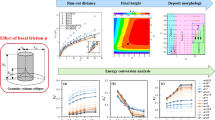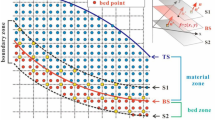Abstract
Post-earthquake debris flows that have occurred in Sichuan Province in southwestern China following the Wenchuan earthquake on May 12, 2008, have caused significant damage and casualties. Previous earthquake-induced landslides produced large amounts of loose material that remained on the steep slopes and in the gullies. As a consequence of heavy rainstorms during the rainy seasons, the existing loose material was transformed into numerous debris flows. Research has shown that the debris flows in the Wenchuan earthquake disaster areas have been characterized by their large scale, high speed, long run-out, and destructive impact. In order to identify the areas potentially at risk and to predict the flow severity, an accurate numerical method is needed to simulate these debris flows. In this paper, we have proposed a smoothed particle hydrodynamics (SPH) modeling technique—a meshfree particle method—to simulate the post-earthquake debris flows in the Wenchuan earthquake disaster areas. The SPH modeling technique introduces a Bingham model to analyze the relationship between material stress rates and particle motion velocity. Compared to traditional numerical methods, the SPH modeling technique is a true meshfree method of a pure Lagrangian nature. It can instantaneously track the motion of each particle, accurately predict the velocity, and naturally handle problems with extremely large deformations. In addition, the SPH method is based on continuum mechanics, and is therefore an efficient method to simulate large-scale debris flows. In this work, first, a viscoplastic fluid was simulated and verified with experimental results in order to evaluate the accuracy of the SPH model. Then propagation analysis of two typical post-earthquake debris flows in earthquake-hit areas was carried out, applying the SPH model. The simulation results showed good agreement with the limited field observation data. Our proposed SPH numerical modeling is able to capture the fundamental dynamic behavior of post-earthquake debris flows and can partially explain these complex phenomena. These simulation results can provide a preliminary scientific basis for hazard assessment and site selection for reconstruction in earthquake-prone areas.












Similar content being viewed by others
References
Atkin RJ, Craine RE (1976) Continuum theories of mixtures: basic theory and historical development. Q J Mech Appl Mech 29(2):209–244
Beguería S, Van Asch TWJ, Malet JP, Gröndahl S (2009) A GIS-based numerical model for simulating the kinematics of mud and debris flows over complex terrain. Nat Hazards Earth Sys Sci 9:1897–1909
Bui HH, Fukagawa R, Sakom K, Ohno S (2008) Lagrangian meshfree particles method (SPH) for large deformation and failure flows of geomaterial using elastic-plastic soil constitutive model. Int J Numer Anal Methods 32(12):1537–1570
Chen CL (1988) Generalized viscoplastic modeling of debris flow. J Fluid Mech 114(3):237–258
Chen H, Hawkin AB (2009) Relationship between earthquake disturbance, tropical rainstorms and debris movement: an overview from Taiwan. Bull Eng Geol Environ 68(2):161–186
Chen H, Lee CF (2000) Numerical simulation of debris flows. Can Geotech J 37(1):146–160
Chen RH, Ou TL (2006) Initiation mechanism of zonal debris flows. Sino Geotech 110:25–34 (in Chinese)
Cui P, Chen XQ, Zhu YY, Su HF, Wei FQ, Han YS, Liu HJ, Zhuang JQ (2011) The Wenchuan earthquake (May 12, 2008), Sichuan Province, China, and resulting geohazards. Nat Hazards 56(1):19–36
Dai ZL, Huang Y, Cheng HL, Xu Q (2014) 3D numerical modeling using smoothed particle hydrodynamics of flow-like landslide propagation triggered by the 2008 Wenchuan earthquake. Eng Geol 180:21–23
Hsiao DH, Hsieh CS, Chang JJ (2011) Disaster investigation and failure analysis of debris flow from Morakot Typhoon at Liugui Town, Kaohsiung, Taiwan on August 8, 2009. In: Proceedings of the twenty-first international offshore and polar engineering conference, Maui, Hawaii, pp 782–788
Huang RQ, Li WL (2009a) Development and distribution of geohazards triggered by 5.12 Wenchuan earthquake in China. Sci China Ser E Technol Sci 52(4):810–819
Huang RQ, Li WL (2009b) Analysis of the geo-hazards triggered by the 12 May 2008 Wenchuan Earthquake, China. Bull Eng Geol Environ 68(3):363–371
Huang Y, Zhang WJ, Mao WW, Jin C (2011) Flow analysis of liquefied soils based on smoothed particle hydrodynamics. Nat Hazards 59(3):1547–1560
Huang Y, Chen W, Liu J (2012a) Secondary geological hazard analysis in Beichuan after the Wenchuan earthquake and recommendations for reconstruction. Environ Earth Sci 66(4):1001–1009
Huang Y, Zhang WJ, Xu Q, Xie P, Hao L (2012b) Run-out analysis of flow-like landslides triggered by the Ms 8.0 2008 Wenchuan earthquake using smoothed particle hydrodynamics. Landslides 9(2):275–283
Huang Y, Dai ZL, Zhang WJ, Huang MS (2013) SPH-based numerical simulations of flow slides in municipal solid waste landfills. Waste Manag Res 31(3):256–264
Hungr O (1995) A model for the runout analysis of rapid flow slides, debris flows and avalanches. Can Geotech J 32(4):610–623
Iverson RM (1997) The physics of debris flows. Rev Geophys 35(3):245–296
Jakob M, McDougall S, Weatherly H, Ripley N (2013) Debris-flow simulations on Cheekye River, British Columbia. Landslides 10(6):685–699
Kaitna R, Rickenmann D, Schatzmann M (2007) Experimental study on rheologic behaviour of debris flow material. Acta Geotech 2(2):71–85
Laigle D, Coussot P (1997) Numerical modeling of mudflows. J Hydraul Eng 123(7):617–623
Laigle D, Lachamp P, Naaim M (2007) SPH-based numerical investigation of mudflow and other complex fluid flow interactions with structures. Comput Geosci 11(4):297–306
Liu MB, Liu GR (2010) Smoothed particle hydrodynamics (SPH): an overview and recent developments. Arch Comput Methods Eng 17(1):25–76
Liu KF, Mei CC (1989) Slow spreading of a sheet of Bingham fluid on an inclined plane. J Fluid Mech 207:505–529
Liu ZQ, Sun SQ (2009) The disaster of May 12th Wenchuan earthquake and its influence on debris flows. J Geogr Geol 1(1):26–30
Lucy LB (1977) A numerical approach to the testing of the fission hypothesis. Astron J 82(12):1013–1024
Ma Y, Yu B, Wu YF, Zhang JN, Yuan X (2011) Research on the disaster of debris flow of Bayi Gully, Longchi, Dujiangyan, Sichuan on August 13, 2010. J Sichuan Univ (Eng Sci Ed) 43(S1):92–97 (in Chinese)
Marr JG, Elverhøi A, Harbitz C, Imran J, Harff P (2002) Numerical simulation of mud-rich subaqueous debris flows on the glacially active margins of the Svalbard–Barents Sea. Mar Geol 188(3–4):351–364
Mazzanti P, De Blasio FV (2011) The dynamics of coastal landslides: insights from laboratory experiments and theoretical analyses. Bull Eng Geol Environ 70(3):411–422
Medina V, Hürlimann M, Bateman A (2008) Application of FLATModel, a 2D finite volume code, to debris flows in the northeastern part of the Iberian Peninsula. Landslides 5(1):127–142
Minatti L, Pasculli A (2011) SPH numerical approach in modelling 2D muddy debris flow. In: Proceedings of international conference on debris-flow hazards mitigation: mechanics, prediction, and assessment, Padova, pp 467–475. doi:10.4408/IJEGE.2011-03.B-052
Monaghan JJ (1994) Simulating free surface flows with SPH. J Comput Phys 110(2):399–406
Monaghan JJ, Lattanzio JC (1985) A refined particle method for astrophysical problems. Astron Astrophys 149(1):135–143
Morris JP, Fox PJ, Zhu Y (1997) Modeling low Reynolds number incompressible flows using SPH. J Comput Phys 136(1):214–226
O’Brien JS, Julien PY, Fullerton WT (1993) Two dimensional water flood and mudflow simulation. J Hydraul Eng 119(2):244–261
Pasculli A, Minatti L, Sciarra N, Paris E (2013) SPH modeling of fast muddy debris flow: numerical and experimental comparison of certain commonly utilized approaches. Ital J Geosci 132(3):350–365
Randles PW, Libersky LD (1996) Smoothed particle hydrodynamics some recent improvements and applications. Comput Methods Appl Mech Eng 139(1–4):375–408
Rickenmann D (1999) Empirical relationships for debris flows. Nat Hazards 19(1):47–77
Rickenmann D, Laigle D, McArdella BW, Hüblb J (2006) Comparison of 2D debris-flow simulation models with field events. Comput Geosci 10(2):241–264
Shao SD, Lo EYM (2003) Incompressible SPH method for simulating Newtonian and non-Newtonian flows with a free surface. Adv Water Resour 26(7):787–800
Shieh CL, Jan CD, Tsai YF (1996) A numerical simulation of debris flow and its application. Nat Hazards 13(1):39–54
Shieh CL, Chen YS, Tsai YJ, Wu JH (2009) Variability in rainfall threshold for debris flow after the Chi-Chi earthquake in central Taiwan, China. Int J Sediment Res 24(2):177–188
Sichuan Province Geological Engineering Complex (2010) Investigation report on the ‘813’ Wenjia gully debris flow, pp 23
Tang C, Zhu J, Li WL (2009) Rainfall-triggered debris flows following the Wenchuan earthquake. Bull Eng Geol Environ 68(2):187–194
Tang C, van Asch TWJ, Chang M, Chen GQ, Zhao XH, Huang XC (2012) Catastrophic debris flows on 13 August 2010 in the Qingping area, southwestern China: the combined effects of a strong earthquake and subsequent rainstorms. Geomorphology 139–140:559–576
Uzuoka R, Yashima A, Kawakami T, Konrod JM (1998) Fluid dynamics based prediction of liquefaction induced lateral spreading. Comput Geotech 22(3–4):234–282
Van Asch TWJ, Malet JP, Remaître A, Maquaire O (2004) Numerical modeling of the run-out of a muddy debris flow, The effect of rheology on velocity and deposit thickness along the run-out track. In: Proceedings of the 9th international symposium on landslides, London, pp 1433–1438. doi:10.1201/b16816-204
Wu FQ, Fu BH, Li X, Liu JY (2008) Initial analysis of the mechanism of the Wenchuan Earthquake (Southwest China), 12 May 2008. Bull Eng Geol Environ 67(4):453–455
Xie H, Zhong DL, Jiao Z, Zhang JS (2008) Debris flow in Wenchuan quake-hit area in 2008. J Mt Sci 27(4):501–509 (in Chinese)
Xie T, Yang HJ, Wei FQ, Gardner JS, Dai ZQ, Xie XP (2014) A new water-sediment separation structure for debris flow defense and its model test. Bull Eng Geol Environ. doi:10.1007/s10064-014-0585-9
Xu Q (2010) The 13 August 2010 catastrophic debris flows in Sichuan Province: characteristics, genetic mechanism and suggestions. J Eng Geol 18(5):596–608 (in Chinese)
Xu Q, Fan XM, Huang RQ, Van Westen C (2009) Landslide dams triggered by the Wenchuan Earthquake, Sichuan Province, south west China. Bull Eng Geol Environ 68(3):373–386
Xu Q, Zhang S, Li WL, van Asch TWJ (2012) The 13 August 2010 catastrophic debris flows after the 2008 Wenchuan earthquake, China. Nat Hazards Earth Syst Sci 12(1):201–216
Yang ZQ, Liao YP, Yang WK, Hu J (2011) Discussion on genesis development trend control engineering of debris flow in Niumiangou valley. J Geod Geodyn 31(5):71–74 (in Chinese)
Yin YP (2009) Rapid and long run-out features of landslides triggered by the Wenchuan earthquake. J Eng Geol 17(2):153–166 (in Chinese)
Yin YP, Zheng WM, Li XC, Sun P, Li B (2011) Catastrophic landslides associated with the M8.0 Wenchuan earthquake. Bull Eng Geol Environ 70(1):15–32
Yu B (2008) Research on the calculating the density the deposit of debris flow. Acta Sedimentol Sin 26(5):789–796 (in Chinese)
Zhang ZG, Zhang ZM, Zhang SB (2010) Formation conditions and dynamics features of the debris flow in Bayi Gully in Dujiangyan County. Chin J Geol Hazard Control 21(1):34–38 (in Chinese)
Zhou W, Chen NS, Deng MF, Yang CL, Yang L (2011) Dynamic characteristics and hazard risk assessment of debris flow in Bayi Gully in Dujiangyan City of Sichuan Province. Bull Soil Water Conserv 31(5):138–143 (in Chinese)
Acknowledgments
This work was supported by the National Natural Science Foundation of China and the Japan Society for the Promotion of Science under the China-Japan Scientific Cooperation Program (Grant No. 41211140042), the National Basic Research Program of China (973 Program, Grant No. 2012CB719803), the National Science Fund for Distinguished Young Scholars of China (Grant No. 41225011), and the Chang Jiang Scholars Program of China.
Author information
Authors and Affiliations
Corresponding author
Rights and permissions
About this article
Cite this article
Huang, Y., Cheng, H., Dai, Z. et al. SPH-based numerical simulation of catastrophic debris flows after the 2008 Wenchuan earthquake. Bull Eng Geol Environ 74, 1137–1151 (2015). https://doi.org/10.1007/s10064-014-0705-6
Received:
Accepted:
Published:
Issue Date:
DOI: https://doi.org/10.1007/s10064-014-0705-6




